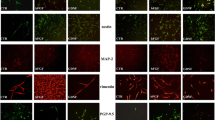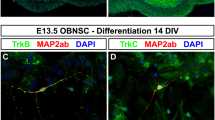Abstract
Ghrelin (Ghre), a gut–brain peptide hormone, plays an important role in the entire olfactory system and in food behavior regulation. In the last years, it has aroused particular interest for its antioxidant, anti-inflammatory, and anti-apoptotic properties. Our previous research showed that Ghre and its receptor are expressed by peculiar glial cells of the olfactory system: Olfactory Ensheathing Cells (OECs). These cells are able to secrete different neurotrophic factors, promote axonal growth, and show stem cell characteristics. The aim of this work was to study, in an in vitro model, the effect of Ghre on both cell viability and the expression of some neural markers, such as Nestin (Ne), Glial Fibrillary Acid Protein (GFAP), Neuregulin (Neu), and β-III-tubulin (Tuj1), in primary mouse OEC cultures. The MTT test and immunocytochemical procedures were used to highlight cell viability and marker expression, respectively. Our results demonstrate that Ghre, after 7 days of treatment, exerted a positive effect, stimulating OEC viability compared with cells without Ghre treatment. In addition, Ghre was able to modify the expression of some biomarkers, increasing Neu and Tuj1 expression, while GFAP was constant; on the contrary, the presence of positive Ne cells was drastically reduced after 7 days, and this showed a loss of stem cell characteristic and therefore the possible orientation towards an adult neural phenotype.





Similar content being viewed by others
References
Abramoff MD, Magalhaes PJ, Ram SJ (2004) Image processing with ImageJ. Biophotonics International 11:36–42
Agarwal A, Zhang M, Trembak-Duff I, Unterbarnscheidt T, Radyushkin K, Dibaj P, Martins de Souza D, Boretius S, Brzózka MM, Steffens H, Berning S, Teng Z, Gummert MN, Tantra M, Guest PC, Willig KI, Frahm J, Hell SW, Bahn S, Rossner MJ, Nave KA, Ehrenreich H, Zhang W, Schwab MH (2014) Dysregulated expression of neuregulin-1 by cortical pyramidal neurons disrupts synaptic plasticity. Cell Rep 8(4):1130–1145
Alexander L, Fitzgerald UF, Barnett SC (2002) Identification of growth factors that promote long-term proliferation of olfactory ensheathing cells and modulate their antigenic phenotype. Glia 37(4):349–364
Barber PC, Dahl D (1987) Glial fibrillary acidic protein (GFAP)-like immunoreactivity in normal and transected rat olfactory nerve. Exp Brain Res 65:681–685
Belin S, Ornaghi F, Shackleford G, Wang J, Scapin C, Lopez-Anido C et al (2019) Neuregulin 1 type III improves peripheral nerve myelination in a mouse model of congenital hypomyelinating neuropathy. Hum Mol Genet 28(8):1260–1273
Berrout L, Isokawa M (2012) Ghrelin promotes reorganization of dendritic spines in culture rat hippocampal slices. Neurosci Lett 516:280–284
Chuah MI, Au C (1993) Cultures of ensheathing cells from neonatal rat olfactory bulbs. Brain Res 601(1-2):213–220
Chung H, Park S (2016) Ghrelin regulates cell cycle-related gene expression in cultured hippocampal neural stem cells. J Endocrinol 230(2):239–250
Cowley MA, Smith RG, Diano S, Tschöp M, Pronchuk N, Grove KL, Strasburger CJ, Bidlingmaier M, Esterman M, Heiman ML, Garcia-Segura LM, Nillni EA, Mendez P, Low MJ, Sotonyi P, Friedman JM, Liu H, Pinto S, Colmers WF, Cone RD, Horvath TL (2003) The distribution and mechanism of action of ghrelin in the CNS demonstrates a novel hypothalamic circuit regulating energy homeostasis. Neuron 37(4):649–661
Franceschini IA, Barnett SC (1996) Low-affinity NGF-receptor and E-N-CAM expression define two types of olfactory nerve ensheathing cells that share a common lineage. Dev Biol 173:327–343
Franssen EH, de Bree FM, Verhaagen J (2007) Olfactory ensheathing glia: their contribution to primary olfactory nervous system regeneration and their regenerative potential following transplantation into the injured spinal cord. Brain Res 56:236–258
Gómez RM, Ghotme K, Botero L, Bernal JE, Pérez R, Barreto GE, Bustos RH (2016) Ultrastructural analysis of olfactory ensheathing cells derived from olfactory bulb and nerve of neonatal and juvenile rats. Neurosci Res 103:10–17
Gómez RM, Sánchez MY, Portela-Lomba M, Ghotme K, Barreto GE, Sierra J, Moreno-Flores MT (2018) Cell therapy for spinal cord injury with olfactory ensheathing glia cells (OECs). Glia 66(7):1267–1301
Halliday GM, Cullen KM, Krill JJ, Harding AJ, Harasty J (1996) Glial fibrillary acidic protein (GFAP) immunohistochemistry in human cortex: a quantitative study using different antisera. Neurosci Lett 209(1):29–32
Huang EJ, Reichardt LF (2001) Neurotrophins: roles in neuronal development and function. Annu Rev Neurosci 24:677–736
Itoh T, Satou T, Nishida S, Hashimoto S, Ito H (2006) Cultured rat astrocytes give rise to neural stem cells. Neurochem Res 31:1381–1387
Jiao Q, Du X, Li Y, Gong B, Shi L, Tang T, Jiang H (2017) The neurological effects of ghrelin in brain diseases: beyond metabolic functions. Neurosci Biobehav Rev 73:98–111
Kafitz KW, Greer CA (1999) Olfactory ensheathing cells promote neurite extension from embryonic olfactory receptor cells in vitro. Glia 25(2):99–110
Kent BA, Beynon AL, Hornsby AKE, Bekinschtein P, Bussey TJ, Davies JS, Saksidaa LM (2015) The orexigenic hormone acyl-ghrelin increases adult hippocampal neurogenesis and enhances pattern separation. Psychoneuroendocrinology 51:431–439
Liu J, Chen M, Dong R, Sun C, Li S, Zhu S (2019) Ghrelin promotes cortical neurites growth in late stage after oxygen-glucose deprivation/reperfusion injury. J Mol Neurosci 68:29–37
Moreno-Flores MT, Diaz-Nido J, Wandosell F, Avila J (2002) Olfactory ensheathing glia: drivers of axonal regeneration in the central nervous system? J Biomed Biotechnol 2(1):37–43
Moreno-Flores MT, Lim F, Martìn-Bermejo MJ, Dìaz-Nido J, Avila J, Wandosell F (2003) Immortalized olfactory ensheathing glia promote axonal regeneration of rat retinal ganglion neurons. J Neurochem 85:861–871
Muller TD, Nogueiras R, Andermann ML, Andrews ZB, Anker SD, Argente J et al (2015) Ghrelin. Mol Metab 4(6):437–460
Omar M, Hansmann F, Kreutzer R, Kreutzer M, Brandes G, Wewetzer K (2013) Cell type- and isotype-specific expression and regulation of β-tubulins in primary olfactory ensheathing cells and Schwann cells in vitro. Neurochem Res 38(5):981–988
Panagopoulos VN, Ralevski E (2014) The role of ghrelin in addiction: a review. Psychopharmacology (Berl.) 231(14):2725–2740
Pastrana E, Moreno-Flores MT, Avila J, Wandosell F, Minichiello L, Diaz-Nido J (2007) BDNF production by olfactory ensheathing cells contributes to axonal regeneration of cultured adult CNS neurons. Neurochem Int 50(3):491–498
Pekny M, Wilhelmsson U, Bogestal YR, Pekna M (2007) The role of astrocytes and complement system in neural plasticity. Int Rev Neurobiol 82:95–111
Pellitteri R, Spatuzza M, Russo A, Stanzani S (2007) Olfactory ensheathing cells exert a trophic effect on the hypothalamic neurons in vitro. Neurosci Lett 417(1):24–29
Pellitteri R, Spatuzza M, Russo A, Zaccheo D, Stanzani S (2009) Olfactory ensheathing cells represent an optimal substrate for hippocampal neurons: an in vitro study. Int J Dev Neurosci 27(5):453–458
Pellitteri R, Spatuzza M, Stanzani S, Zaccheo D (2010) Biomarkers expression in rat olfactory ensheathing cells. Front Biosci 2:289–298
Ramón-Cueto A, Avila J (1998) Olfactory ensheathing glia: properties and function. Brain Res Bull 46(3):175–187
Ramón-Cueto A, Cordero MI, Santos-Benito FF, Avila J (2000) Functional recovery of paraplegic rats and motor axon regeneration in their spinal cords by olfactory ensheathing glia. Neuron. 25(2):425–435
Rieske P, Azizi SA, Augelli B, Gaughan J, Krynska B (2007) A population of human brain parenchymal cells express markers of glial, neuronal and early neural cells and differentiate into cells of neuronal and glial lineages. Eur J Neurosci 25:31–37
Russo C, Patanè M, Vicario N, Di Bella V, Cosentini I, Barresi V, Gulino R, Pellitteri R, Russo A, Stanzani S (2020) Olfactory ensheathing cells express both ghrelin and ghrelin receptor in vitro: a new hypothesis in favor of a neurotrophic effect. Neuropeptides 79:101997. https://doi.org/10.1016/j.npep.2019.101997
Russo C, Russo A, Pellitteri R, Stanzani S (2017) Hippocampal ghrelin-positive neurons directly project to arcuate hypothalamic and medial amygdaloid nuclei. Could they modulate food-intake? Neurosci Lett 653:126–131
Russo C, Russo A, Pellitteri R, Stanzani S (2018) Ghrelin-containing neurons in the olfactory bulb send collateralized projections into medial amygdaloid and arcuate hypothalamic nuclei: neuroanatomical study. Exp Brain Res 236(8):2223–2229
Stoyanova II, Hofmeijer J, van Putten MJAM, le Feber J (2016) Acyl ghrelin improves synapse recovery in an in vitro model of postanoxic encephalopathy. Mol Neurobiol 53:6136–6143
Stoyanova II, le Feber J, Rutten WLC (2013) Ghrelin stimulates synaptic formation in cultured cortical networks in a dose-dependent manner. Regul Pept 186:43–48
Thompson RJ, Roberts B, Alexander CL, Williams SK, Barnett SC (2000) Comparison of neuregulin-1 expression in olfactory ensheathing cells, Schwann cells and astrocytes. J Neurosci Res 61:172–185
Vincent AJ, West AK, Chuah MI (2005) Morphological and functional plasticity of olfactory ensheathing cells. J Neurocytol 34(1–2):65–80
von Bohlen und Halbach O (2007) Immunohistological markers for staging neurogenesis in adult hippocampus. Review. Cell Tissue Res 329:409–420
Woodhall E, West AK, Chuah MI (2001) Cultured olfactory ensheathing cells express nerve growth factor, brain-derived neurotrophic factor, glia cell line-derived neurotrophic factor and their receptors. Brain Res Mol Brain Res 88(1–2):203–213
Young ER, Jialal I (2019) Biochemistry, ghrelin. StatPearls, Treasure Island (FL)
Acknowledgments
This research was supported by University of Catania (Italy). Cristina Russo is a PhD student of the International PhD Program in Neuroscience, University of Catania, Catania (Italy). We wish to thank the Scientific Bureau of the University of Catania for language support.
Author information
Authors and Affiliations
Contributions
Cristina Russo: conceptualization, data curation, formal analysis, investigation, methodology.
Martina Patanè: methodology, data curation.
Antonella Russo: data curation, formal analysis, project administration, supervision, validation, visualization.
Stefania Stanzani: conceptualization, data curation, funding acquisition, investigation, project administration, resources, supervision, validation, visualization, roles/writing—original draft, writing—review and editing.
Rosalia Pellitteri: methodology, data curation, supervision, validation, visualization, roles/writing—original draft, writing—review and editing.
Corresponding author
Ethics declarations
Conflict of Interest
The authors declare that they have no conflict of interest.
Ethical Approval
All applicable international, national, and institutional guidelines for the care and use of animals were followed.
Additional information
Publisher’s Note
Springer Nature remains neutral with regard to jurisdictional claims in published maps and institutional affiliations.
Rights and permissions
About this article
Cite this article
Russo, C., Patanè, M., Russo, A. et al. Effects of Ghrelin on Olfactory Ensheathing Cell Viability and Neural Marker Expression. J Mol Neurosci 71, 963–971 (2021). https://doi.org/10.1007/s12031-020-01716-3
Received:
Accepted:
Published:
Issue Date:
DOI: https://doi.org/10.1007/s12031-020-01716-3




